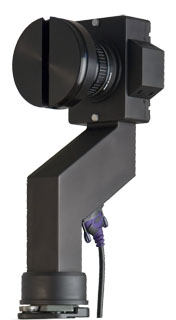Panoscan: Difference between revisions
copy-edit; rem some peacocky text; condense and clarify. |
adding Highton website as inline reference using cite web; removing from references section as redundant. |
||
| Line 3: | Line 3: | ||
[[Image:MK3.jpg|thumbnail|Panoscan MK-3 Camera]] |
[[Image:MK3.jpg|thumbnail|Panoscan MK-3 Camera]] |
||
The '''Panoscan''' is a high resolution digital [[Panoramic photography|panoramic]] [[rotating line camera]], manufactured by Panoscan Inc. The first Panoscan camera, called MK-1, were manufactured in 1999, with MK-2 and MK-3 models, with |
The '''Panoscan''' is a high resolution digital [[Panoramic photography|panoramic]] [[rotating line camera]], manufactured by Panoscan Inc. The first Panoscan camera, called MK-1, were manufactured in 1999, with MK-2 and MK-3 models, with higher resolution and speed, followed. |
||
| ⚫ | The Panoscan camera uses a tri-linear [[charge-coupled device|CCD]] array and assembles an image by capturing a single line of pixels at a time while rotating through a 400 degree arc. The camera produces digital images of 9,000 by 65,000 pixels that can be printed at 30 feet (10 [[metre]]s) in length. The camera incorporates a [[pan mechanism]] and does not require an external unit. <ref name="Highton"> {{cite web |
||
|url = http://www.vrphotography.com/data/pages/vrbooksamples/ch8.html |
|||
|title = Virtual Reality Photography by Scott Highton - Chapter 8 Excerpt |
|||
|year = 2010 |
|||
|accessdate = 16 September 2010 |
|||
|format = JPEG}}</ref> |
|||
| ⚫ | The Panoscan camera uses a tri-linear [[charge-coupled device|CCD]] array and assembles an image by capturing a single line of pixels at a time while rotating through a 400 degree arc. The camera produces digital images of 9,000 by 65,000 pixels that can be printed at 30 feet (10 [[metre]]s) in length. |
||
The MK-3 Panoscan camera accepts [[medium format (film)|medium format]] [[photographic lens|lenses]] from 22.5 mm up to 300 mm focal lengths. Panoscan cameras can be used with a special 22.5 mm [[fisheye lens]] to capture completely spherical images for use in computer-based virtual reality players such as [[QuickTime VR]]. The images can be used for measurement purposes such as [[Photogrammetry]]. A photogrammetry application for measuring the panoramic images, called PanoMetric, is available. |
The MK-3 Panoscan camera accepts [[medium format (film)|medium format]] [[photographic lens|lenses]] from 22.5 mm up to 300 mm focal lengths. Panoscan cameras can be used with a special 22.5 mm [[fisheye lens]] to capture completely spherical images for use in computer-based virtual reality players such as [[QuickTime VR]]. The images can be used for measurement purposes such as [[Photogrammetry]]. A photogrammetry application for measuring the panoramic images, called PanoMetric, is available. |
||
| Line 12: | Line 18: | ||
{{Reflist}} |
{{Reflist}} |
||
Eric Reinhard, Grag Ward, Sumanta Pattanaik, Paul Debevec. (2006). ''High Dynamic Range Imaging Acquisition, Display and Image-Based Lighting''. Morgan Kaufmann. p. 390-391. ISBN-13: 978-0-12-585263-0. ISBN-10: 0-12-585263-0 |
Eric Reinhard, Grag Ward, Sumanta Pattanaik, Paul Debevec. (2006). ''High Dynamic Range Imaging Acquisition, Display and Image-Based Lighting''. Morgan Kaufmann. p. 390-391. ISBN-13: 978-0-12-585263-0. ISBN-10: 0-12-585263-0 |
||
Scott Highton. (2010) [http://www.vrphotography.com/bookpromo.html ''Virtual Reality Photography Creating Panoramic and Object Images'']. Highton. p. viii, xi, 83, 99, 112, 129, 130, 138, 144. ISBN: 978-0-615-34223-8 |
|||
Vernon J. Geberth. (2006) ''Practical Homicide Investigation Tactics, Procedures, and Forensic Techniques 4th Edition''. p. 149-152. ISBN: 0-8493-3303-2 |
Vernon J. Geberth. (2006) ''Practical Homicide Investigation Tactics, Procedures, and Forensic Techniques 4th Edition''. p. 149-152. ISBN: 0-8493-3303-2 |
||
Revision as of 20:32, 16 September 2010
This article has multiple issues. Please help improve it or discuss these issues on the talk page. (Learn how and when to remove these template messages)
No issues specified. Please specify issues, or remove this template. |

The Panoscan is a high resolution digital panoramic rotating line camera, manufactured by Panoscan Inc. The first Panoscan camera, called MK-1, were manufactured in 1999, with MK-2 and MK-3 models, with higher resolution and speed, followed.
The Panoscan camera uses a tri-linear CCD array and assembles an image by capturing a single line of pixels at a time while rotating through a 400 degree arc. The camera produces digital images of 9,000 by 65,000 pixels that can be printed at 30 feet (10 metres) in length. The camera incorporates a pan mechanism and does not require an external unit. [1]
The MK-3 Panoscan camera accepts medium format lenses from 22.5 mm up to 300 mm focal lengths. Panoscan cameras can be used with a special 22.5 mm fisheye lens to capture completely spherical images for use in computer-based virtual reality players such as QuickTime VR. The images can be used for measurement purposes such as Photogrammetry. A photogrammetry application for measuring the panoramic images, called PanoMetric, is available.
References
- ^ "Virtual Reality Photography by Scott Highton - Chapter 8 Excerpt" (JPEG). 2010. Retrieved 16 September 2010.
Eric Reinhard, Grag Ward, Sumanta Pattanaik, Paul Debevec. (2006). High Dynamic Range Imaging Acquisition, Display and Image-Based Lighting. Morgan Kaufmann. p. 390-391. ISBN-13: 978-0-12-585263-0. ISBN-10: 0-12-585263-0
Vernon J. Geberth. (2006) Practical Homicide Investigation Tactics, Procedures, and Forensic Techniques 4th Edition. p. 149-152. ISBN: 0-8493-3303-2
